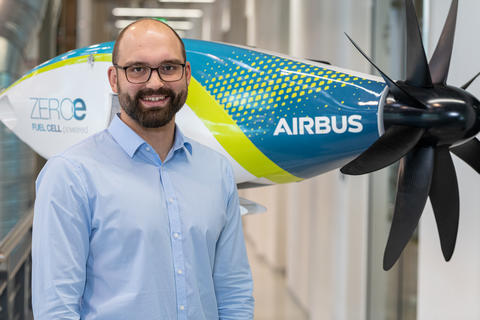At the drawing board: designing ZEROe aircraft
For four years, Daniel has been working as an overall aircraft design engineer for the ZEROe project. Balancing the pros and cons of every design decision, he and his team are responsible for exploring concepts and designing the ZEROe aircraft that will eventually take to the skies by 2035.

What is your role on the ZEROe team?
I am an overall aircraft design engineer in the Future Projects Office, which handles the preliminary design of all new Airbus aircraft. This is a multinational team spread throughout Europe, and I work at the Centre of Applied Aeronautical Research (ZAL) in Hamburg.
My role is to contribute to the design of a viable aircraft configuration that satisfies all requirements, including but not limited to performance, ground handling, payload (passengers and cargo) accommodations and handling qualities. A balance that makes sense at an overall aircraft level must be found between all these different requirements. For example, something that is beneficial for performance might be bad for maintenance or manufacturing. So we have to make decisions on these kinds of trade-offs.
For ZEROe, the process is even more delicate, as some of the principles we use to design conventional aircraft concepts do not apply to a hydrogen-powered aircraft. For example, fuel storage.
While jet fuel is stored in the wings of a conventional aircraft, a hydrogen-powered aircraft needs dedicated hydrogen tanks stored in cryogenic conditions. For technical reasons, it doesn’t make sense to put these hydrogen tanks in the wings, so we had to design the system from scratch.
What attracted you to the ZEROe project?
I like to learn new things and push the boundaries of technology, which is why I initially joined the Future Projects Office. When I was asked to support the ZEROe project, I felt it would be a good opportunity to shape the future of sustainable air transportation, as well as to learn more about hydrogen propulsion systems.
What is the best part of your job?
The versatility. As an overall aircraft design engineer, I cover all engineering disciplines, which makes it an extremely interesting job. For example, in a single day I can work on aerodynamics, weight estimation, engine performance and 3D geometry. It's a job where I learn something new almost every day.
What does an average day look like for you?
My job is fully digital, and my daily responsibilities are divided between a coordination and management role and a technical role. On the management side, I coordinate timelines and inputs across other teams. I make sure that they have all the information they need, and I ensure that they contribute the correct quality inputs on time. Meanwhile, the technical aspect of my role involves everything from doing calculations and technical drawings to plotting and visualising results. I always keep a classic pocket calculator with me! I receive a lot of inputs about the aircraft from other teams and I use these to build up a thorough understanding that allows me to judge whether designs received from other teams are aligned with expectations.
When I was a kid, I was fascinated with space. This later evolved into a passion for aviation, as I grew up near Manching, Germany, home of the Bundeswehr Flight Test Centre, where I could see jets taking off and landing almost every day. I wanted to work at Airbus because it is the only place to be if you want to be at the forefront of technological innovation in aviation!
What is your most memorable moment at Airbus?
I joined Airbus Defence and Space in 2011, as part of a dual study programme with my university. While there, I had the opportunity to visit a customer to discuss their needs and concerns. They were very open about the strengths of our product, but they were also honest about its weaknesses. It was valuable to receive this kind of open feedback because it challenged my views on our product and led me to change my perspective.
This interaction serves as a reminder of how we always need to remember that we are building our aircraft for the customer. Our priority must always be on delivering the best performance possible.
What advice would you give to a new overall aircraft design engineer at Airbus?
I would advise a new engineer to never accept that something is impossible as long as it is not against the laws of physics. When we say something is impossible, we tend to mean there is a certain cost to do it, such as added weight. But at the early stages of a new aircraft’s development we have a lot of design freedom and it is important to keep all doors open. Additionally, an engineer must always be able to explain their results. Before starting calculations or simulations, they should have a rough expectation of the results and should take the time to go through the steps and make sure they understand how they arrived at the output.
I would also share some of the best advice I myself have received, which is to always challenge design requirements. They have often been inherited from previous programmes or are based on legacy assumptions, and they might no longer be relevant. They really drive an aircraft’s design, so it’s important to always confirm if they are still necessary.
